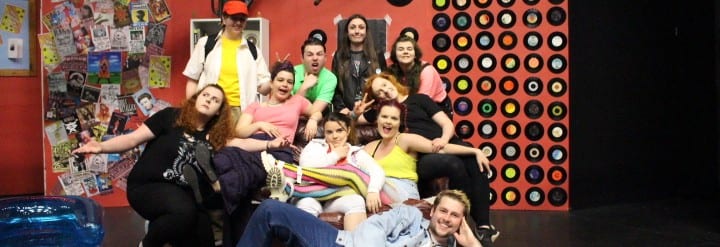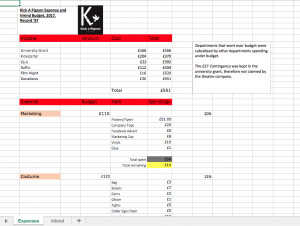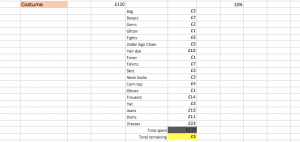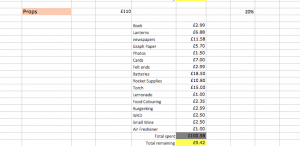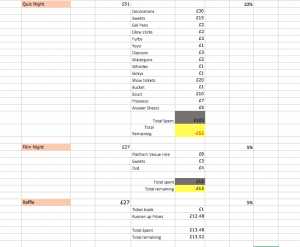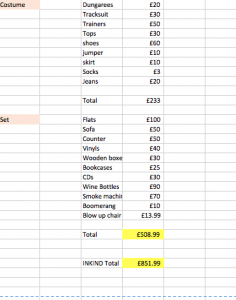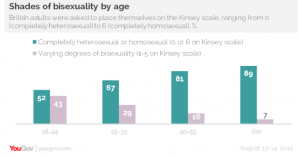As producer, it was my responsibility to manage the company’s financial expenses, ensuring the budget remained in a positive figure.
As the show was primarily funded by the donations of the public through our Kickstarter project, it was imperative I created a budget sheet which was both understandable and accessible for the public to view via our website. Especially due to “the current financial climate, it is important to show that public funds invested in art and culture deliver public benefit and value and that our funded organisations manage themselves well and are prepared for all eventualities” (Artscouncil.org.uk, 2017).
I collated all incomings, outgoings and in-kind expense into an excel spreadsheet and set up the formulas needed so I could manage the changing expense with ease. Initially, I distributed a set percentage of our funding to each area of our production, i.e. Set, props. However, as the module and our show developed, I soon realised that some areas would need a bigger budget where as others would need less. For example, less money was spent out of the set budget than originally expected, due to the in-kind donations we received, meaning the left over money could help fund other areas, for example marketing.
The only area which financially, would not be considered successful. The Quiz did not turn over a profit or earn the same amount of money spent on the event, this is the only area on the spreadsheet which spent more than it’s entitled budget. If our money had been granted by an organisation such as the Arts Council England, then this may have led to them cutting our funding, as it may suggest the funding is not being spent wisely. But as previously mentioned, this event was a success for the marketing and publicity of the theatre company and the show. The company also sold many raffle tickets at the quiz, however this is not reflected in the budget due to the reflective categories.
This process has been a great learning curve in financing, budgeting and funding a company and performance, as from this journey I have learned the great and the not so great funding methods. To fund Kick a Pigeon Theatre and Record ‘97 in the future I would create a Kickstarter project again, as this proved to be a massive success for us, raising the core amount of our budget and our followers. However, I will also look at other means of funding, for example, I would consider spending more time in the streets with my company talking to the public about the show and our vision. This has proven to be successful for many theatres companies for example Full Frontal Theatre, whom in their starting year did exactly this. I’ve found that funding methods and events work best when they also marketing and promoting your latest performance and allowing the company to build a relationship with the public.
Applying for funding via Arts Council England is a method which may be the company’s strongest means of funding. However, I am fully aware this funding is not easy to obtain, due to the cuts that the Arts face, and both the company and show would have to ‘give back’ to the public in return of the money received.
“Funding is provided on the basis that each organisation makes a contribution to the delivery of our goals, using mutually agreed special, measurable, achievable, relevant and time-based (SMART) objectives that are embedded in organisations’ business (or programme), equality action and audience development plans” (Artscouncil.org.uk 2017).
To meet these requirements and to contribute to their goals and the community, Kick a Pigeon’s plans to tour sixth forms, colleges and universities holding workshops around the basis of ‘finding yourself’ and the tricky years of early adulthood. For example, the friendship between Sebastian and David explores both sexuality, acceptance and rejection, issues that many young people now face. As according to the 2015 Kinsey scale “43% [of young people] place themselves in the non-binary area” (Dahlgreen et al., 2017) of bisexuality.
Therefore, these workshops would fit the Arts Council England’s plans the company will be contributing to society via educational workshops, whilst widening our target audience.
Works Cited:
Artscouncil.org.uk. (2017). Arts Council England |. [online] Available at: http://www.artscouncil.org.uk [Accessed 14 May 2017].
Dahlgreen, W., Shakespeare, A., Dahlgreen, W. and Shakespeare, A. (2017). YouGov | 1 in 2 young people say they are not 100% heterosexual. [online] YouGov: What the world thinks. Available at: https://yougov.co.uk/news/2015/08/16/half-young-not-heterosexual/ [Accessed 30 May 2017].
Figure 1: Bailey, N. (2017) Kick a Pigeon Budget 2017. Lincoln: University of Lincoln.
Figure 2: Bailey, N. (2017) Kick a Pigeon Budget 2017. Lincoln: University of Lincoln.
Figure 3: Bailey, N. (2017) Kick a Pigeon Budget 2017. Lincoln: University of Lincoln.
Figure 4: Bailey, N. (2017) Kick a Pigeon Budget 2017. Lincoln: University of Lincoln.
Figure 5: Bailey, N. (2017) Kick a Pigeon Budget 2017. Lincoln: University of Lincoln.
Figure 6: Bailey, N. (2017) Kick a Pigeon Budget 2017. Lincoln: University of Lincoln.
Figure 7: Bailey, N. (2017) Kick a Pigeon Budget 2017. Lincoln: University of Lincoln.
Figure 8: Bailey, N. (2017) Kick a Pigeon Budget 2017. Lincoln: University of Lincoln.
Figure 9: Dahlgreen, W., Shakespeare, A., Dahlgreen, W. and Shakespeare, A. (2017). YouGov | 1 in 2 young people say they are not 100% heterosexual. [online] YouGov: What the world thinks. Available at: https://yougov.co.uk/news/2015/08/16/half-young-not-heterosexual/ [Accessed 30 May 2017].
